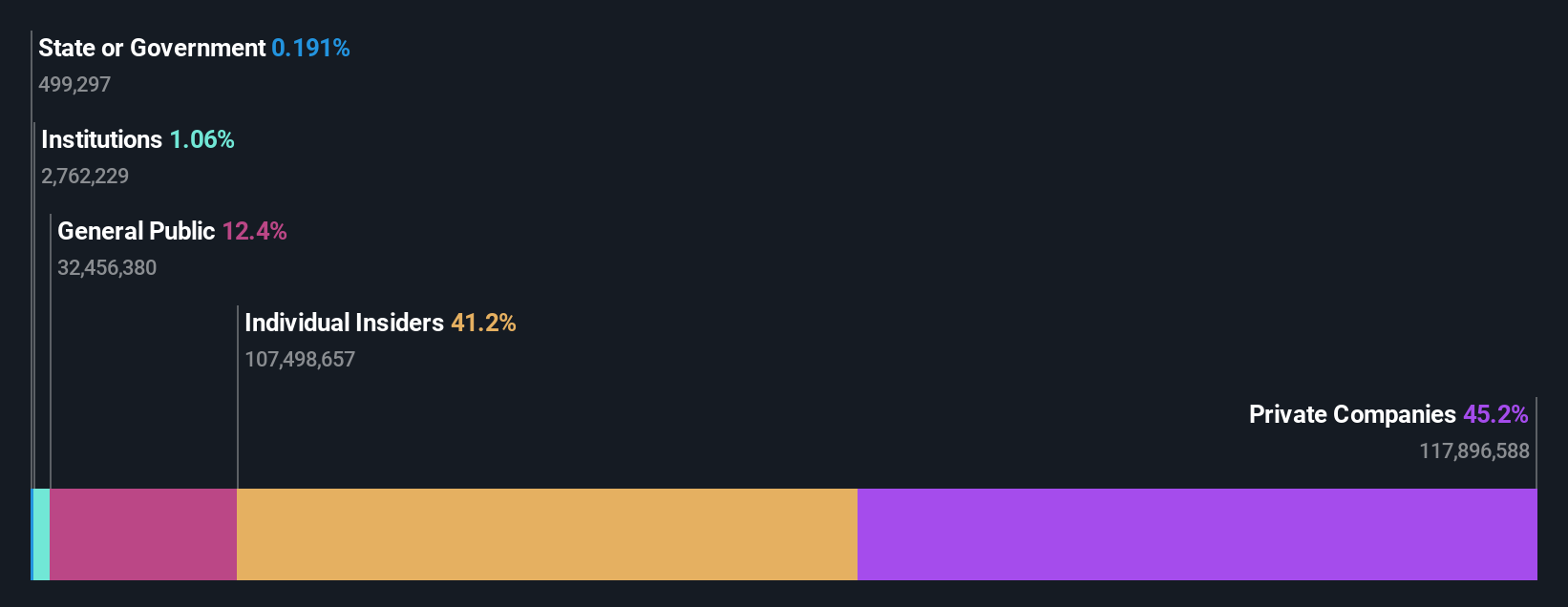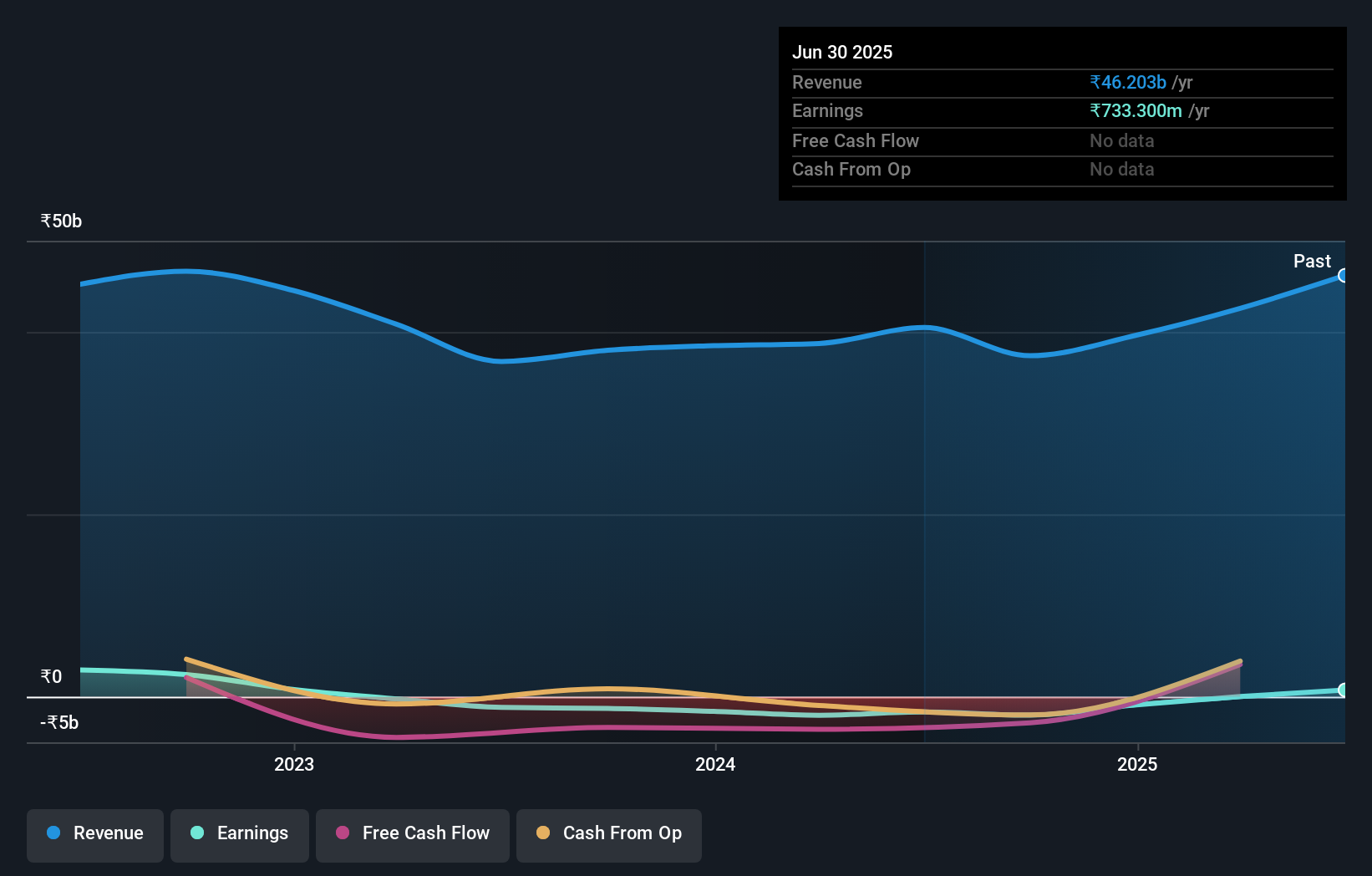Indo Rama Synthetics (India) Limited's (NSE:INDORAMA) market cap rose ₹1.9b last week; private companies who hold 45% profited and so did insiders
Key Insights
- Significant control over Indo Rama Synthetics (India) by private companies implies that the general public has more power to influence management and governance-related decisions
- The top 2 shareholders own 74% of the company
- Insider ownership in Indo Rama Synthetics (India) is 41%
If you want to know who really controls Indo Rama Synthetics (India) Limited (NSE:INDORAMA), then you'll have to look at the makeup of its share registry. The group holding the most number of shares in the company, around 45% to be precise, is private companies. In other words, the group stands to gain the most (or lose the most) from their investment into the company.
Private companies gained the most after market cap touched ₹19b last week, while insiders who own 41% also benefitted.
Let's take a closer look to see what the different types of shareholders can tell us about Indo Rama Synthetics (India).
View our latest analysis for Indo Rama Synthetics (India)

What Does The Institutional Ownership Tell Us About Indo Rama Synthetics (India)?
Institutions typically measure themselves against a benchmark when reporting to their own investors, so they often become more enthusiastic about a stock once it's included in a major index. We would expect most companies to have some institutions on the register, especially if they are growing.
Less than 5% of Indo Rama Synthetics (India) is held by institutional investors. This suggests that some funds have the company in their sights, but many have not yet bought shares in it. If the business gets stronger from here, we could see a situation where more institutions are keen to buy. We sometimes see a rising share price when a few big institutions want to buy a certain stock at the same time. The history of earnings and revenue, which you can see below, could be helpful in considering if more institutional investors will want the stock. Of course, there are plenty of other factors to consider, too.

We note that hedge funds don't have a meaningful investment in Indo Rama Synthetics (India). Canopus International Ltd. is currently the company's largest shareholder with 39% of shares outstanding. With 35% and 6.6% of the shares outstanding respectively, Om Lohia and Siam Stock Holdings Limited are the second and third largest shareholders. Om Lohia, who is the second-largest shareholder, also happens to hold the title of Chief Executive Officer.
A more detailed study of the shareholder registry showed us that 2 of the top shareholders have a considerable amount of ownership in the company, via their 74% stake.
Researching institutional ownership is a good way to gauge and filter a stock's expected performance. The same can be achieved by studying analyst sentiments. Our information suggests that there isn't any analyst coverage of the stock, so it is probably little known.
Insider Ownership Of Indo Rama Synthetics (India)
The definition of an insider can differ slightly between different countries, but members of the board of directors always count. Company management run the business, but the CEO will answer to the board, even if he or she is a member of it.
I generally consider insider ownership to be a good thing. However, on some occasions it makes it more difficult for other shareholders to hold the board accountable for decisions.
Our information suggests that insiders maintain a significant holding in Indo Rama Synthetics (India) Limited. Insiders have a ₹7.9b stake in this ₹19b business. It is great to see insiders so invested in the business. It might be worth checking if those insiders have been buying recently.
General Public Ownership
The general public, who are usually individual investors, hold a 12% stake in Indo Rama Synthetics (India). While this group can't necessarily call the shots, it can certainly have a real influence on how the company is run.
Private Company Ownership
We can see that Private Companies own 45%, of the shares on issue. It might be worth looking deeper into this. If related parties, such as insiders, have an interest in one of these private companies, that should be disclosed in the annual report. Private companies may also have a strategic interest in the company.
Next Steps:
While it is well worth considering the different groups that own a company, there are other factors that are even more important. Like risks, for instance. Every company has them, and we've spotted 3 warning signs for Indo Rama Synthetics (India) (of which 1 is a bit unpleasant!) you should know about.
Of course, you might find a fantastic investment by looking elsewhere. So take a peek at this free list of interesting companies.
NB: Figures in this article are calculated using data from the last twelve months, which refer to the 12-month period ending on the last date of the month the financial statement is dated. This may not be consistent with full year annual report figures.
New: AI Stock Screener & Alerts
Our new AI Stock Screener scans the market every day to uncover opportunities.
• Dividend Powerhouses (3%+ Yield)
• Undervalued Small Caps with Insider Buying
• High growth Tech and AI Companies
Or build your own from over 50 metrics.
Have feedback on this article? Concerned about the content? Get in touch with us directly. Alternatively, email editorial-team (at) simplywallst.com.
This article by Simply Wall St is general in nature. We provide commentary based on historical data and analyst forecasts only using an unbiased methodology and our articles are not intended to be financial advice. It does not constitute a recommendation to buy or sell any stock, and does not take account of your objectives, or your financial situation. We aim to bring you long-term focused analysis driven by fundamental data. Note that our analysis may not factor in the latest price-sensitive company announcements or qualitative material. Simply Wall St has no position in any stocks mentioned.
About NSEI:INDORAMA
Indo Rama Synthetics (India)
Manufactures and trades polyester products in India, Turkey, Nepal, and internationally.
Low risk with questionable track record.
Similar Companies
Market Insights
Community Narratives



